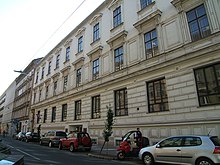Palais Festetics (Vienna)
The Festetics Palace is located in the 9th Viennese district of Alsergrund Berggasse 16th
history
The palace was built in 1858 in the style of the New Vienna Renaissance by the architectural duo Johann Julius Romano (1818–1882) and August Schwendenwein (1817–1885) for Eugénie Countess Festetics von Tolna (1826–1894).
1897 (of which referred Vienna Stock Exchange , Börsegasse 11, of relocating as 1875 Oriental Museum was founded) kk Austrian Trade Museum and Austrian Trade Museum in Vienna the house and used it until 1939. In October 1898 took the Palais the newly founded Imperial Export Academy of the trade museum started teaching and kept it up until the relocation in 1916. In 1961 the building was rebuilt and was used by the Chamber of Commerce in Vienna until 2019. In 2019 the palace passed into the ownership of Signa Holding owned by Tyrolean Rene Benko for around € 17 million and was sold a short time later to the Hallmann real estate holding owned by Viennese investor Klemens Hallmann for around € 31.3 million.
description
The elongated three-storey building rests on a square base zone with a strong cornice and two side arched portals. In the apex of the arch two harpies entwine a double cartridge . The windows of the main floor have a straight Fensterverdachung on consoles . The space between the windows is filled by rectangular plaster field frames. A continuous cornice and protruding parapets emphasize the horizontal line. The windows on the upper floor appear simpler despite a gable roofing, plastering fins with keystone and parapet field framing. In the driveway, pilasters support a barrel vault with straps. A column staircase with wrought iron grille leads to the bel étage with four state rooms in neo-rococo style.
literature
- Adolph Lehmann's general housing advertiser together with a commercial and commercial address book for the imperial capital and residence of Vienna and the surrounding area . Volumes 1.1859–63.1921 / 22, Vienna, ZDB -ID 576123-2 .
- Dehio Vienna, II. To IX. and XX. District . ISBN 3-7031-0680-8 , p. 409.
Individual evidence
- ^ Austrian Trade Museum. In: Neue Freie Presse , Morgenblatt, No. 11971/1897, December 20, 1897, p. 3 middle. (Online at ANNO ). .
- ↑ K. k. Austrian trade museum . In: Lehmann , edition 1896, p. 121, center right - online .
- ↑ Berggasse 16 . In: Lehmann , 1939 edition, p. 458 - online .
- ^ Wilma Buchinger, Konstanze Mittendorfer: Handbook of the historical book stocks in Austria . Volume 1: Vienna , part 1. Olms-Weidmann, Hildesheim (inter alia) 1994, ISBN 3-487-09905-5 , p. 270 f. - text online .
- ↑ Chamber of Commerce opened new headquarters. Wien.orf.at, April 30, 2019, accessed on May 1, 2019 .
- ↑ Vienna Chamber of Commerce opens House of Vienna Business. In: DiePresse.com. April 30, 2019, accessed August 11, 2019 .
Remarks
- ↑ The Oriental Museum was located from 1875 to 1879 at Renngasse 12, Vienna- Innere Stadt ; from 1880 to 1887 on Börsegasse 3, Vienna-Innere Stadt; as the Imperial and Royal Austrian Trade Museum from 1888 to 1893 on Börsegasse 3, from 1894 to 1896 on Börsegasse 11, from 1897 on Berggasse 16. (evidence according to Lehmann ).
Web links
- Planet-Vienna: Palais Festetics
- Entry via Palais Festetics on Burgen-Austria
Coordinates: 48 ° 13 ′ 5.4 " N , 16 ° 21 ′ 45.1" E
